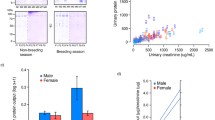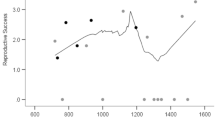Abstract
The physiological basis for population differentiation of dispersal timing during individual development in male wild house mice is still unknown. As major urinary proteins (MUPs) are known to convey information about competitive ability in male mice, we examined individual MUP profiles defined by isoelectric-focusing (IEF) patterns in relation to developmental timing of dispersive motivation. As an experimental paradigm marking the development of the dispersal propensity, we used agonistic onset between litter mate brothers when kept in pairs under laboratory conditions. Agonistic onset is known to reflect the initiation of dispersive motivation. Hence, we compared individual MUP IEF patterns between fraternal pairs that did or did not develop agonistic relationships before the age of 2 months. Urine was collected on the day of weaning and at the beginning of adulthood. We investigated whether there was a significant co-occurrence of particular MUP IEF patterns with the agonistic onset in male mice. We assumed that, based on this co-occurrence, particular MUP IEF patterns and/or a particular dynamic of MUP IEF expression from weaning to adulthood may be considered a physiological predictor of a specific behavioral strategy in male mice (i.e. submissive-philopatric or agonistic-dispersive strategy). We found that agonistic males expressed more MUP IEF bands than amicable ones at weaning, but these differences disappeared later on. The presence of two particular IEF bands at weaning was significantly associated with early agonistic onset. Our study suggests that MUPs could have a predictive value for the onset of aggressive behavior and dispersal tendency in male wild house mice.


Similar content being viewed by others
References
Anderson PK (1990) Dispersal in rodents: a resident fitness hypothesis. American Society of Mammalogists, Vertebrate Museum, Shippensburg
Bacchini A, Gaetani E, Cavaggioni A (1992) Pheromone binding proteins of the mouse, Mus musculus. Experientia 48:419–421
Beynon RJ, Hurst JL (2003) Multiple roles of major urinary proteins in the house mouse, Mus domesticus. Biochem Soc Trans 31:142–146
Beynon RJ, Hurst JL (2004) Urinary proteins and the modulation of chemical scents in mice and rats. Peptides 25:1553–1563
Bocskei Z, Groom CR, Flower DR, Wright CE, Phillips SE, Cavaggioni A, Findlay JB, North AC (1992) Pheromone binding to two rodent urinary proteins revealed by X-ray crystallography. Nature 360:186–188
Brennan P, Peele P (2003) Towards an understanding of the pregnancy-blocking urinary chemosignals of mice. Biochem Soc Trans 31:152–155
Cavaggioni A, Findlay JB, Tirindelli R (1990) Ligand binding characteristics of homologous rat and mouse urinary proteins and pyrazine-binding protein of calf. Comp Biochem Physiol 96:513–520
Clissold PM, Hainey S, Bishop JO (1984) Messenger-RNAs coding for mouse major urinary proteins are differentially induced by testosterone. Biochem Genet 22:379–387
Compaan JC, Hutchison JB, Wozniak A, Deruiter AJH, Koolhaas JM (1994) Brain aromatase activity and plasma testosterone levels are elevated in aggressive male mice during early ontogeny. Dev Brain Res 82:185–192
Corti M, Rohlf FJ (2001) Chromosomal speciation and phenotypic evolution in the house mouse. Biol J Linn Soc 73:99–112
Gerlach G (1996) Emigration mechanisms in feral house mice—a laboratory investigation of the influence of social structure, population density, and aggression. Behav Ecol Sociobiol 39:159–170
Humphries RE, Robertson DHL, Beynon RJ, Hurst JL (1999) Unravelling the chemical basis of competitive scent marking in house mice. Anim Behav 58:1177–1190
Hurst JL, Beynon RJ (2004) Scent wars: the chemobiology of competitive signalling in mice. BioEssays 26:1288–1298
Hurst JL, Robertson DHL, Tolladay U, Beynon RJ (1998) Proteins in urine scent marks of male house mice extend the longevity of olfactory signals. Anim Behav 55:1289–1297
Hurst JL, Payne CE, Nevison CM, Marie AD, Humphries RE, Robertson DHL, Cavaggioni A, Beynon RJ (2001) Individual recognition in mice mediated by major urinary proteins. Nature 414:631–634
Johnson ML, Gaines MS (1990) Evolution of dispersal: theoretical models and empirical tests using birds and mammals. Ann Rev Ecol Syst 21:449–480
Knopf J, Held WA (1980) Hormonal regulation of the mouse major urinary proteins. Eur J Cell Biol 22:150–159
Krackow S (2003) Motivational and heritable determinants of dispersal latency in wild male house mice (Mus musculus musculus). Ethology 109:671–689
Krackow S (2005) Agonistic onset during development differentiates wild house mouse males (Mus domesticus). Nature 92:78–81
Lidicker WZ (1976) Social behaviour and density regulation in house mice living in large enclosures. J Anim Ecol 45:677–697
Mackintosh JH (1981) Behaviour of the house mouse. Symp Zool Soc Lond 47:337–365
Marie AD, Veggerby C, Robertson DHL, Gaskell SJ, Hubbard SJ, Martinsen L, Hurst Jl, Beynon RJ (2001) Effect of polymorphisms on ligand binding by mouse major urinary proteins. Protein Sci 10:411–417
Mucignat-Caretta C, Cavaggioni A, Caretta A (2004) Male urinary chemosignals differentially affect aggressive behavior in male mice. J Chem Ecol 30:777–791
Nevison CM, Armstrong S, Beynon RJ, Humphries RE, Hurst JL (2003) The ownership signature in mouse scent marks is involatile. Proc R Soc Lond B 270:1957–1963
Novotny M, Harvey S, Jemiolo B, Alberts J (1985) Synthetic pheromones that promote inter-male aggression in mice. Proc Natl Acad Sci 82:2059–2061
Novotny M, Soini HA, Koyama S, Wiesler D, Bruce KE, Penn DJ (2007) Chemical identification of MHC-influenced volatile compounds in mouse urine. I: Quantitative proportions of major chemosignals. J Chem Ecol 33:417–434
Payne CE, Malone N, Humphries R, Bradbrook C, Veggerby C, Beynon R, Hurst JL (2001) Heterogeneity of major urinary proteins in house mice: population and sex differences. In: Marchlewska-Koj A (ed) Chemical signals in vertebrates, vol 9. Kluwer Academic/Plenum, Dordrecht
Robertson DHL, Cox KA, Gaskell SJ, Evershed RP, Beynon RJ (1996) Molecular heterogeneity in the major urinary proteins of the house mouse Mus musculus. Biochem J 316:265–272
Robertson DHL, Hurst JL, Bolgar MS, Gaskell SJ, Beynon RJ (1997) Molecular heterogeneity of urinary proteins in wild house mouse populations. Rapid Commun Mass Spectrom 11:786–790
Rosenbrock H, Hagemeyer CE, Singec I, Knoth R, Volk B (1999) Testosterone metabolism in rat brain is differentially enhanced by phenytonin-inducible cytochrome P450 isoforms. J Neuroendocrinol 11:597–604
Rusu AS, Krackow S (2005) Agonistic onset marks emotional changes and dispersal propensity in wild house mouse males (Mus domesticus). J Comp Psychol 119:58–66
Stenseth NC, Lidicker WZ (1992) Animal dispersal: small mammals as a model. Chapman & Hall, London
Stoscheck C (1990) Quantification of protein. Methods Enzymol 182:50–68
Van Zegeren K (1980) Variation in aggressiveness and the regulation of number in house mouse population. Neth J Zool 30:635–770
Volf P, Skarupova S, Man P (2002) Characterization of the lectin from females of Phlebotomus duboscqi sand flies. Eur J Biochem 269:1–8
Westermeier R (2001) Electrophoresis in practice, 3rd edn. Wiley-VCH/Weinheim, New York
Acknowledgements
We are indebted to three anonymous reviewers for valuable comments on former drafts of this manuscript. Our thanks also go to Jari Garbely for help with any laboratory matter arising and to Alan G. McElligott and Marius I. Benta for reviewing the English. Support from German Research Foundation (Heisenberg programme KR1290/6) to SK, Swiss National Fond (research grant 3100–59609) to BK and SK, Grant Agency of the Czech Republic (grant no. 206/04/0493) to PS and PJ, and from Competence Center for Gender Studies in Zurich and from Romanian Ministry of Education and Research (grant CEEX no. 3210/14.10.05) to AR is kindly acknowledged.
Author information
Authors and Affiliations
Corresponding author
About this article
Cite this article
Rusu, A.S., Krackow, S., Jedelsky, P.L. et al. A qualitative investigation of major urinary proteins in relation to the onset of aggressive behavior and dispersive motivation in male wild house mice (Mus musculus domesticus). J Ethol 26, 127–135 (2008). https://doi.org/10.1007/s10164-007-0042-3
Received:
Accepted:
Published:
Issue Date:
DOI: https://doi.org/10.1007/s10164-007-0042-3




